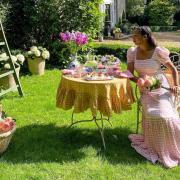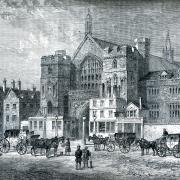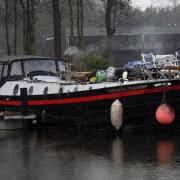Thomas Baines was born in King’s Lynn in 1820, when the town was still a major seaport, especially serving the whaling trade, even building its own ships to undertake these dangerous voyages.
Baines’s grandfather had been a master mariner, engaged in the trade, but it was a hard life, and he died young. His son, John, was ‘looked after’ by his uncle, a doctor, in London. The uncle was unenthusiastic about his unsought role, and quickly acted to remove the encumbrance by sending his nephew into the navy. Having prospered in the service John returned to King’s Lynn becoming a master mariner, and in January 1820 he married Mary Ann Watson, the daughter of a local painter and decorator. That November Thomas Baines was born, followed by several others only two of whom survived into adulthood, one, Henry, also became a professional artist though remaining in Norfolk.
Thomas’s mother was a formidable lady and the driving force in the Baines household. She was responsible for his early education, though it was his grandfather who encouraged and instructed him, in the art of drawing and painting. His enthusiasm at an early age was later described by an aunt who recalled that, aged just five, he sobbed when taken to see the famous Wombwell menagerie, that he had no pencil to draw the animals. The deficiency corrected, he happily produced ‘some nice little sketches’. His fondness for art continued and, at 16, he was apprenticed to a carriage painter.

At 21, with his apprenticeship finished, he decided to travel. It wasn’t just a sense of adventure which drove him – he certainly had that, but it was perhaps disappointment in love, when his cousin Emma rejected his marriage proposal, that was responsible for the timing of his departure. The ‘where’ was easy for him – his father, who had visited the Cape many times in his navy career painted a romantic picture of the life and scenery which appealed to the artist in him. What’s more, he had distant relatives in Durban.
The snag with the choice of South Africa was that, unlike Australia and New Zealand there were no government sponsored schemes to encourage emigration, and Thomas not only had to sail steerage, but also was so short of cash that on arrival at Cape Town he could not afford to go ashore and take lodgings. It was fortunate that the master of the schooner, Olivia, William Roome, was also a King’s Lynn man and an acquaintance of the family - he allowed Thomas to remain on board for a week. Recognising the quality of the art he had produced during the voyage, he was confident that Thomas would soon find employment, as he quickly did. Within weeks his restless spirit led him to leave the job and take irregular employment as assistant to a coachbuilder, his duties including the painting of the coaches. Irregular as the employment was, it suited Thomas, who could spend his free time painting, and had the use of the store of colours kept by his employer. It was the start of an extraordinary adult life – a peripatetic one of adventure, danger, a degree of fame, and alleged infamy.

Thomas was a regular churchgoer and became friendly with the organist who encouraged him to do a painting of the church. This was executed with such skill that his patron arranged commissions from enough friends to persuade Thomas to take up art as a full-time occupation. He was successful from the start. Specialising in marine subjects and portraiture, he was especially well positioned in Cape Town with its busy nautical scenes and its businessmen happy to pay to preen themselves for sittings with the talented young artist.
Soon he became irritated with portrait clients who made demands for absurd additions to their portraits and who argued about costs, anyway, simply having to be available to carry out the commissions restricted his opportunities for travel. For relaxation he worked on subjects which appealed to him and produced an un-commissioned painting of one of the actions of the ongoing Kaffir War – his first of a genre for which he was to become known.
Later, Thomas set out on his own, sleeping rough, eating what he could find, and sketching places and people as he went. Occasionally he would run into small groups of soldiers with whom he might spend a couple of days, before leaving again. Many of those he thus met confidently expected him to have his throat slit by the increasingly belligerent indigenous population, as the Kaffir Wars ignited. Somehow, he survived, and, adding the sketching of war scenes to his portfolio, returned to Grahamstown. Although his work was admired it didn’t sell well and he struggled to make ends meet. Probably to his relief, some officers of a Highland Regiment were very taken with his work and he was given a place on the staff of the regiment with rations both for him and his horse and commissioned to paint scenes of the war.

These sketches attracted attention at home, and he started producing work for the Illustrated London News. However, that organ wasn’t in the business of promoting the careers of its contributors, and his work was published anonymously. Most of the work that went home was sent to his formidable mother who proved a determined and successful publicity agent, even sending some of the illustrations to Queen Victoria. Although unsolicited they did receive a gracious royal acknowledgement, and she successfully sought royal patronage, soon reproductions of his work were reproduced by the Queen’s preferred lithographers. He was beginning to be noticed.
Thomas, though tempted to return home stayed on in Africa to complete his ambitious exploration plans and he spent eleven years there before coming home. It had been 11 years of considerable satisfaction for him, but not of financial success. When he managed to get a berth on a sailing ship in 1853, he boarded her with all the worldly wealth he had accumulated in those years – 7/6d (37.5p)!

Arrived in London, he set out, not with great success, to promote the sale of the reproductions of his work. He visited King’s Lynn and helped to set up an exhibition and gave a number of talks about his adventures. But money was in short supply and he had new responsibilities following the death of his father. He must have been relieved when he was asked to join an expedition to northern Australia in a combined role as storekeeper and artist. Although led by an experienced explorer it seems to have been planned on a shoestring basis with the leader’s inexperienced brother as second in command, an absent-minded German as botanist, a gardener’s boy to assist with the collection of specimens, and a surgeon who hadn’t even sat his final examinations. For Baines it proved a success. Not only was a river in northern Australia named after him but his work in mapping the area may have been the cause of his election as a Fellow of the Royal Geographical Society on his return, and the award of its Gold Medal in 1858.
This was perhaps the high point of his career, and he was invited to travel with David Livingstone as storekeeper and artist on the explorer’s expedition to the Zambesi. The expedition had ambitious objectives, including the investigation of possible sites for commercial development. But for all its good intentions, the expedition was not recognised widely as a success, and for Thomas Baines it proved a disaster.
The problem lay in his relationship with the Livingstones, not just David, but also his brother Charles. Appointed in the somewhat nebulous role of ‘moral agent’ – effectually he was David’s deputy, though that role belonged officially to a Royal Navy officer, Commander Bedingfield, at the outset. While Livingstone was undoubtedly a great explorer he was not the easiest man for whom to work – he wasn’t a good man manager, and it wasn’t long before he had rubbed Bedingfield up the wrong way. In a blitz of mutual recriminations Bedingfield left, and even more responsibility devolved on Thomas.

Charles Livingstone does not emerge with credit from what then ensued. He seems not just to have been barely competent, but also idle and seemingly imbued with a determination to damage the reputation both of Bedingfield and, especially, Thomas Baines. Worse still, he had his brother’s ear, and for all the latter’s reputation as an explorer he was not, it would seem, open-minded. Charles reportedly made himself repeatedly unpleasant to other members of the expedition. JPR Wallis, the author of a 1941 biography of Thomas Baines describes Charles as ‘the weakest member of the party, the idlest and the most mischievous’. Sadly, at this stage his brother still had total faith in him. Later he was to change his view, describing Charles as a valueless assistant. But when Charles laid charges against Baines alleging theft of material, including canvas for painting, David Livingstone swallowed the story whole. Baines totally rejected the allegations and his version of events would have been supported by other members of the party, had they had the chance to do so. But Livingstone brooked no enquiry – time was short and eventually he dismissed Thomas, having first written a letter to his sponsors, asserting that Thomas was guilty. When Thomas Baines returned to England, he strove repeatedly to have a formal enquiry set up, but not only had too much time passed since the alleged offences but David Livingstone was also an apparently unimpeachable ‘national treasure’. It is not to Livingstone’s credit that, despite eventually realising that, as he put it, ‘the one mistake of the Expedition had been bringing Charles into it’ he went out of his way to avoid Baines and any suggestion of reviewing the matter. His judgement was to have a material affect on Baines’ future employability.
Thomas Baines, who had regularly suffered from dysentery and tropical diseases did not perhaps get the recognition he deserved, but he was a man on a mission who lived for his painting and the roving life. Industrious, honest, and hard-working and it is sad that he never won the widespread recognition and financial success he deserved. He was almost certainly the first artist ever to capture the grandeur of Victoria Falls. We are fortunate that, in the Museum at King’s Lynn and in southern Africa, his story lives on and examples of his paintings can be seen.
He died, in his cousin’s house at Durban, at the age of 55, still in the South Africa he had loved so dearly. It is fitting that a memorial to him in that city reads A man to whom the wildness brought gladness and the mountains, peace’.



























